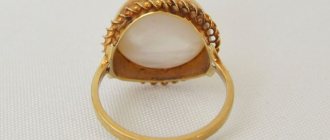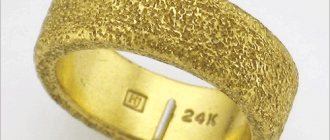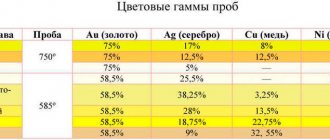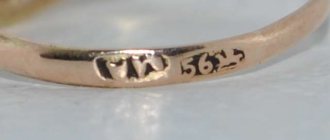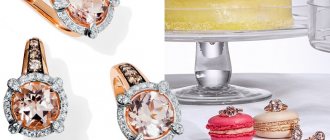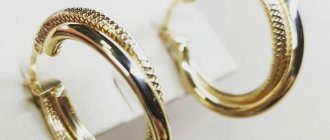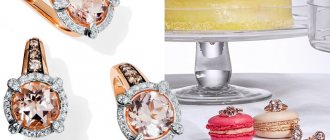Almost every person has gold jewelry. This is a classic gift for loved ones for an anniversary or wedding. Having twirled the product in their hands, people discover the treasured sample and calm down. Engraved numbers are taken as confirmation of genuine gold, but few people are interested in what exactly they mean and what other markings there are.
What is a sample?
Gold is a soft metal, with a Mohs hardness rating of only 2.5. A ring of pure yellow metal can be deformed when squeezed between your fingers with little force. However, gold items are worn daily, passed down from one generation to another, and their appearance is perfect. The secret lies in the additives - ligatures. The practice of adding base impurities to noble metals is aimed at increasing the strength characteristics of the former. Additives may be present in different proportions. The brand determines the presence of a ligature, or, more precisely, how much pure gold is in the material.
There are 4 classifications of markings:
- carat;
- lot;
- spool;
- metric.
In modern life, a metric classification is used to indicate the purity of gold. It is this that is indicated on objects in a series of three numbers.
Black gold
One of the latest trends in jewelry production. To obtain black gold, it is combined with cobalt and chromium, but the trouble is that these metals do not mix well. The exact manufacturing technology of this rare, expensive and elegant metal still remains a mystery to most manufacturers. But some have still learned to obtain a similar effect using ruthenium or rhodium, applying them to the surface of products using the galvanic method or, for example, by patination with oxygen and sulfur.
Yellow gold remains the most popular. But if you are bored with the shade of the sun or simply don’t suit your look, you don’t have to change your favorite metal. Black, white, colored, different shapes and designs, with or without stones, smooth or openwork - you will find a product to suit any preference.
Types of gold samples
In the Russian Empire, spool standards were used to assess the quality of gold. They existed for almost two hundred years, the numbering consisted of only two digits. On gold items made in the early 18th century, you can see a hallmark of, for example, 36 or 92. The marking was based on a measure of weight, 1 spool was equal to 1/96 of a pound. Translated into the metric manner of sealing, 36 spools are comparable to the modern 385 mark, 56 spools are comparable to the 585 mark, and so on. The mark of 94 spools is comparable to the 980 mark of gold, but it is no longer in use.
The lot system, like the spool system, was also cancelled. It was popular in Western Europe in the Middle Ages. The weight of gold was measured in marks; one mark was equal to 16 lots. There were five lot samples (6, 8, 12, 14 and 16 lots).
To convert to the metric system, use a simple formula: the number of lots is multiplied by 62.5. It turns out that 6 lots correspond to modern 375 hallmark, 8 lots – 500 hallmark, and so on.
The carat system is based on a non-systemic unit of mass. One carat equals 0.2 grams. This is the weight of a carob pod. It was he who was chosen to designate the mass of precious stones and pearls. One gram of gold is equal to 5 carats.
In the USA and Europe, the karat system is used to assess the quality of gold products.
The essence of the marking is based on the understanding that the product is divided into twenty-four parts. For example, one kilogram of gold is represented as 24 carats, and the item is marked as pure gold. 18K purity means that out of 24 parts of the material, 18 parts (i.e. 75%) are pure gold. If this value is multiplied by a thousand and divided by 24, the result is 750 metric standard, which means the presence of 750 grams of natural gold in the alloy.
By origin
The origin of gold jewelry determines its color, quality, and characteristics. This is due to the fact that in all countries there is a personal approach and understanding of what products made of precious metal should be like. This may be determined by traditions, economic parameters, etc.
Chinese
China, like Japan, highly reveres the sun and its embodiment. Gold for the Chinese is a good example of the latter. That is why jewelry of at least 750 standard predominates in the country, and white and red precious metals are almost never found.
Since the alloys contain a large percentage of pure gold, Chinese products are ductile and brittle. Under strong mechanical stress, they break, bend, and become deformed.
The Chinese themselves do not consider this drawback to be significant, since they almost never wear gold jewelry in everyday life. Most of the time they are stored in special boxes, from which they are removed on major holidays.
Italian
Jewelry houses in Italy produce jewelry mainly in pink, white and yellow shades. This is due to the fact that it is customary here to add silver to alloys of precious metals, and other elements are used rarely and in minimal quantities. Another difference between Italian jewelry is the whimsicality of shapes and unusual combinations.
Turkish
There are no gold deposits in Turkey, but the country compensates for the poverty of its subsoil by purchasing the required amount from other countries. At the same time, in Turkish markets the cost of gold jewelry is often an order of magnitude lower than in importing countries.
The explanation for this phenomenon is very simple - unlike other countries, Turkey has little control over the jewelry industry, and therefore the markings on products do not always correspond to the truth. As a result, under the guise of a 750-karat ring, you can buy a fake copper coated with a thin layer of gold.
Arabic
The gold jewelry that tourists bring from Arab countries is distinguished by its bright, rich hue. This is due to the fact that high-grade alloys predominate there (18 carats and above).
Russian
The quality and content of gold alloys in Russia is regulated by GOST, and it is impossible to sell jewelry without the markings and code of the State Inspectorate. Thanks to this, they are of high quality, last a long time and are quite durable.
Traditionally, most citizens prefer yellow or red gold. However, jewelry made of pink, green, purple and even black metal can also be widely available.
Which sample is better?
From the point of view of the cost of decoration, the 999 sample is considered the best. It is applied in cases where there are no alloying components at all. On the practical side, this brand cannot be the best, since noble metal in its pure form is a very soft material and objects made from it can be damaged with minimal effort. The ligature is added for a reason. It gives the noble metal hardness and resistance to damage.
Experienced jewelers who know a lot about gold claim that the most practical is 750 mark. It contains nickel, silver, copper and platinum. These metals add optimal properties to jewelry, and the metal can be melted down to create new masterpieces.
The 585 brand is considered the most popular among the population. 90% of all gold jewelry (rings, earrings, bracelets, chains) are made from it. Items made from this metal are quite practical, suitable for daily wear and have an affordable price.
White gold
Products of a steel cold shade are slightly inferior in popularity to sunny yellow. White gold goes well with diamonds, making their shine more expressive. Products without stones are also held in high esteem: they go with everything, look noble and elegant.
This color of metal is obtained by adding palladium, nickel, silver or platinum to gold. The alloy with platinum is the most valuable and durable; jewelry made from it does not scratch, does not deform, and retains its attractiveness for a long time.
The cheapest white gold is with a nickel alloy. Products made from such an alloy wear much worse and can also cause allergies. Nickel gives white gold a slight yellowish tint.
Relationship between color and sample
The color of gold items is not always constant. Alloying impurities add their own nuances in the same way as they affect the mechanical properties. Silver adds a hint of green, while platinum acts as a brightener. Items under the same mark may differ in color and shades.
Gold items of 333 stamps range in color from orange to red. This wide spectrum is caused by different percentages of silver and copper. An item can even have a pink tint if there are 200 g of silver and 467 g of copper (based on 1 kg of alloy).
Items with the mark 583 are yellow, green, and red. The dependence is also determined by the content of silver and copper.
Things 750 grade have yellow, pink shades depending on silver and copper, as well as white when replacing copper with nickel.
Colored
Since pure gold is practically not used in the manufacture of jewelry, it is used in combination with other metals. They not only improve its technical characteristics, but also affect the color scheme of the product.
Yellow
The yellow alloy in jewelry is considered one of the traditional ones. In addition to gold, the composition includes silver and copper, and their proportions vary in color from reddish to lemon. Since there are no strict limits on the amount of alloy for yellow gold, its fineness can vary from the lowest (333) to the highest (958) for the alloy.
Red
If in a mixture of aurum, silver and copper a large proportion falls on the latter element, the product becomes red. Its shades were typical for jewelry produced in the USSR, but it is practically not found in modern Russia. Copper color looks good in combination with other metals (rings made of red and white gold are popular), as well as with precious stones.
White
White gold has now overtaken yellow gold in popularity. It is made with the addition of platinum, silver and palladium. The cost of such a product is an order of magnitude higher than the classic yellow alloy.
Among the advantages of “white” jewelry are high durability and attractive color.
In jewelry, 585 and 750 alloys are used. To reduce the cost of jewelry, white gold is often used in combination with more affordable metals.
Green
Green gold is rare, although its recipe is one of the oldest. The first mentions of it date back to the 1st–2nd millennium BC. In Russia, green alloys are manufactured in two variations:
- 58.5% gold and 41% silver – 585 standard;
- 75.0% gold and 25% silver – 750 standard.
The reason for the rarity of green jewelry is their fragility: the metal breaks down under mechanical stress.
Blue and blue
The blue tint of jewelry occurs when indium is added to the composition. Today, such alloys are considered a myth, since all data about them is only theoretical.
The only person who managed to achieve results, Antoniassi, kept the production technology a secret from his contemporaries and descendants. Blue jewelry that can be found on the shelves of jewelry stores today are alloys coated with varnish or rhodium-plated.
The blue tint is quite real and is realized in unusual and eye-catching jewelry. It is obtained by adding chromium and iron to the alloy. However, as with green gold, the resulting alloy becomes too brittle and brittle to be used in everyday jewelry. The best option is to use blue gold as inserts with another metal.
Black
Black gold appeared relatively recently. It can be obtained in several ways, including using modern technologies (exposure to the finished product with a laser). If we talk exclusively about alloys, then chromium and cobalt are added to it to obtain the desired shade.
Gray
Pure gray gold jewelry is extremely rare. A little more often, jewelers produce products with inserts of this alloy. A rare and unusual shade is achieved by adding steel to the composition. To consolidate the result, the finished jewelry is processed using a galvanic method, during which the thinnest metal film is applied to the product.
Pink
Rose gold is considered one of the varieties of red. Its main difference is the presence in the alloy of not only copper, but also silver.
Lemon
Lemon gold is a precious alloy in which silver, along with aurum, predominates.
Violet or amethyst
Adding potassium or aluminum to the composition gives it a violet or lilac hue. Jewelry of this color appeared solely thanks to the curiosity of modern jewelry masters. They found records of purple gold, which was in use in Ancient Egypt, and then, through trial and experimentation, brought its recipe to life.
Brown or brown
Brown gold has been used in jewelry for a long time. However, a few decades ago, only wristwatches were made from it. Today, brown jewelry is found in many collections of jewelry houses and is marked with 585 or 750. The production of a product of the desired shade occurs in several stages.
First, the alloy is prepared, and after the decoration is formed, the second stage begins - it is treated with a special chemical composition.
What samples of gold are there in Russia?
In Russia and the CIS countries, a metric system is used to determine the quality of gold.
The marking shows how much pure gold is contained in the alloy from which the product is made. Officially, 7 stamps are issued in the Russian Federation. The most common is 585, most of the assortment on the jewelry market is made from it. The remaining samples are used less frequently, have a high cost and are purchased to demonstrate status or for a private collection.
The 750 marking is popular among the highest strata of society not only in Russia, but throughout the world. It is in this alloy that the master alloy is chosen so well that the alloy has excellent external characteristics and favorable mechanical properties (strong, elastic, hard, melts well). Products with the 750 mark never wear out, do not lose color, and are highly valued on the market.
In Russia, consumers prefer gold with the 585 mark. The characteristics of the alloy are no worse than the 750 mark, but are much cheaper. Jewelry with this marking is sold in all small jewelry stores, each family has more than one copy and is called mass-produced.
By purpose
Gold can come in the form of bars and jewelry, and can be used even in places you least expect to see it.
Technical
The strength and chemical resistance of gold allows it to be used as a material for electrical contacts, printed circuit boards, connectors and other parts. It replaces the platinum group metals, which have better characteristics but are less expensive.
Gold is also used for soldering metals. And softer alloys are used in ultra-high vacuum technology.
Modern windows, car and stained glass are coated with a thin layer of gold. The presence of such a film reduces heat loss in winter and saves from overheating in summer.
Medical
In the field of medicine, gold alloys are used mainly in two areas: pharmacology and dentistry. In the first case, aurum compounds are added to medicines against arthritis, tuberculosis, malignant tumors, etc. In the second, dentures and crowns are made based on gold and other metals (zinc, copper, silver, platinum, copper).
Chervonnoe
In Rus' it was customary to call gold with a minimum amount of ligature (no more than 10%) red gold. It was used to make coins - chervonets. Pure metal was also widely used for gilding the domes of Orthodox churches. Today, red gold is part of alloys, and in its pure form is found only in the form of bank bars and coins.
Investment
Part of the pure metal obtained after extraction and processing is used as the gold reserve of the country in which it is mined. This is a kind of guarantee that the state’s economy will remain afloat in the event of sharp fluctuations in exchange rates.
The population is guided by a similar principle. Those who prefer to keep their savings in a more reliable equivalent purchase gold coins and bars from banks. Then you can rent a safe deposit box for a certain period or leave the precious metal in your own private collection.
Jewelry
The plasticity and beauty of gold alloys has been appreciated by jewelers since ancient times. Pure metal is practically not used due to its fragility and low wear resistance. It is needed only for creating alloys or gilding products from cheaper materials.
How can I see the sample on products?
To examine the coveted three numbers, you need to arm yourself with a magnifying glass. Even a person with good eyesight can find it difficult to find the marking, since it is deliberately placed in a place hidden from the human eye in order not to spoil the beautiful image of the jewelry. On rings, the mark can be found on the inside side touching the finger. On earrings and chains, the stamp is hidden in a lock. The font is very small and will be difficult to read without a magnifying glass.
The influence of different metals in the alloy on the properties of the gold alloy
Silver makes the alloy more ductile and malleable. It also changes the shade of the alloy, making it whiter. If you add more than 30% silver, the shade of the yellow alloy will become noticeably lighter, and when the amount of silver increases to 65%, the gold will turn white. When copper , the alloy becomes harder, but its anti-corrosion properties are reduced. Copper also gives the alloy a reddish tint. Cadmium makes the alloy more easily melted. It also gives the alloy a greenish tint. Zinc gives the alloy properties similar to cadmium. It brightens the alloy, which is why it is used to make white gold. A small amount of zinc can also make the alloy slightly greener. Palladium makes the alloy more refractory, forcing the heating temperature to increase. Thanks to this, the alloy becomes noticeably more ductile and lighter - palladium colors it white with a slight beige (flesh) tint. Nickel gives the gold alloy its hardness and changes the color of the alloy to pale yellow. Used as a component of white gold. Platinum bleaches gold more intensely than other alloys and increases its elasticity. Yellowness is lost when the alloy contains about 8% platinum. Nickel, platinum and palladium also give white gold alloys high anti-corrosion properties.
Disadvantages of products made from low samples
Jewelry marked from 375 to 500 has a low cost. This alloy is not particularly revered by jewelers, calling it low-grade. The main disadvantage lies in the color, because more than half the weight is taken up by ligatures. With such a percentage of noble metal and impurities, the material simply cannot be saturated yellow. The items often have a distinct green color due to the silver, or a reddish color due to the high copper content. Labor-intensive jewelry is not made from such alloys due to its inexpediency.
Gold in its pure form is a rather impractical material. Gold jewelry is made from alloys with the addition of alloying components. Additives may have different percentages relative to pure gold. For this reason, there was a need to maintain a mark. Samples help determine the amount of noble material in an alloy.
By extraction method
Gold extracted from the depths of the earth is divided into two main groups: endogenous (it is also called indigenous, primary, ore) and exogenous (placer). They differ in the method of formation and depth of occurrence.
Rudnoe
Indigenous gold is the result of magmatic processes that occurred in the earth's crust thousands of years ago. During volcanic eruptions, streams of magma, which are a melt of various compounds, burst to the surface. The elements forming them gradually cooled, but this process was uneven.
The last to remain were the fusible elements located in the center of the magma flow. They did not freeze, but continued to actively circulate until they cracked outward, forming veins. Further decomposition of elements occurred in them until only hot solutions of gold-containing salts remained. Gradually they also solidified and then crumbled, leaving crystals of pure gold.
Placer
The number of exogenous mines is much larger. They are found in all gold-bearing provinces of the world. By its origin, placer gold is endogenous deposits destroyed under the influence of the external environment.
When the bedrock veins are destroyed, the gold crystals are freed from most of the accumulations of foreign ore. Under the influence of rain and melted snow, the placers gradually move down the slope. If a mountain stream comes across the path of the sliding precious metal, the speed of movement increases, and the gold itself ends up in the valleys.
In water, the precious metal is finally cleared of impurities and settles at the bottom. Ores of other metals have less weight and are destroyed or weathered under the influence of river flow. Gold in water moves at a minimum speed, forming a placer.
Photo gallery of different gold samples
Colors of gold alloys depending on composition
| Alloy color | % Au (gold) | % Ag (silver) | % Cu (copper) | % Ni (nickel) | %Zn (zinc) | % Pd (palladium) | % Fe (iron) |
| Light yellow | 58,5 | 32,0 | 9,5 | — | — | — | — |
| Yellow | 58,5 75,0 | 28,0 12,2 | 13,5 12,8 | — | — | — | — |
| Dark yellow | 58,5 | 23,0 | 18,5 | — | — | — | — |
| Pink | 58,5 | 14,0 | 27,5 | — | — | — | — |
| Red | 58,5 75,0 | 7,0 6,0 | 34,5 19,0 | — | — | — | — |
| Green | 58,5 75,0 | 39,0 25,0 | 2,5 — | — | — | — | — |
| White | 58,5 58,5 75,0 | — 18,5 — | 18,5 — 5,5 | 15,5 — 15,5 | 7,5 8,0 4,0 | — 15,0 — | — — — |
| Blue | 75,0 | — | — | — | — | — | 25,0 |
Source: textbook “Jewelry Production Technology” (V.P. Lugovoy)
JEWELERY METALS - CATALOG | JEWELERY METALS - GUIDE
All about gold | All about silver | All about platinum | All about palladium
Gold hallmarks | Physico-chemical properties of gold | How to check gold for authenticity
Share this article with your friends
Works by designers from the JEWELIRUM catalog
- Co.Cos Jewelry
- Co.Cos Jewelry
- Taiga Jewelry, Tomsk
- Taiga Jewelry, Tomsk
- Ilya Maksimov, Crimea
- Ilya Maksimov, Crimea
- UBIRING
- UBIRING
- Diamonds are Forever
- Diamonds are Forever
- Rings in natural style, Sergacheva Jewelery
- Earrings with pearls, Sergacheva Jewelery
- Cabochon ring, Minty Sky
- Fly earrings, Minty Sky
- Ring, Precious Park
- Ring, Precious Park
- Snake skin ring, Stoyanova Jewelery
- Chain earrings, Stoyanova Jewelery
- Children's pendant - stick, Matthew&Daniel
- Pendant for a child, Matthew&Daniel
- Bracelet, Svetlana Subbotina
- Ring with Slavic symbols, Svetlana Subbotina
- Indian style ring, Anna Goffman
- Indian style ring, Anna Goffman
- Earrings, ISTA
- Geometric ring, ISTA
- Earrings with enamel, PNJewelry
- Ring with enamel, PNJewelry
- Ring, Khramtsova Jewelry
- Ring, Khramtsova Jewelry
- Wedding rings to order, obruchalki.com
- Wedding rings to order, obruchalki.com
- Earrings, Yuri Bylkov
- Earrings, Yuri Bylkov
- Titanium bracelets, LanaMuransky
- Titanium pendant, LanaMuransky
- Brooch Elephant (after Salvador Dali), THING
- Ring Veil, THING
- Mace earrings, VLADIMIR MARKIN
- Cufflinks, jewelry mechanics, VLADIMIR MARKIN
- Drop-shaped ring, EKATERINA TOLSTAYA
- Drop-shaped earrings, EKATERINA TOLSTAYA
- Necklace with amber, LETA
- Earrings with amber, LETA
- Children's earrings, combinable, FASHBY
- Children's earrings, combinable, FASHBY
- Ring of architectural form, Elizaveta Malafeevskaya MANU_L
- Architectural bracelet, Elizaveta Malafeevskaya MANU_L
- Set Ginkgo Leaf, SHABUT JEWELLERY
- Brooch Wearable porcelain, SHABUT JEWELLERY
- Architectural ring, GEOMETRY
- Brooch, porcelain, GEOMETRY
- Necklace made of polymer clay, LICORNE ART
- Brooch made of polymer clay, LICORNE ART
- Ring, avant-garde, VALERY SEREDIN
- Bracelet, avant-garde. VALERY SEREDIN
- Wooden set, Scandinavian/Japanese minimalism, VLADIMIR SHESTAKOV
- Ring, Scandinavian/Japanese minimalism, VLADIMIR SHESTAKOV
- Earrings, TON ANT
- Ring, TON ANT
- Architectural ring, ANCHOR
- Architectural necklace, ANCHOR
- Earrings, GOHFELD JEWELLERY
- Necklace, GOHFELD JEWELLERY
- Massive ring, YAKISCHIK
- Designer jewelry, YAKISCHIK
- Architectural ring, ONE DAY ART
- Architectural ring, ONE DAY ART
- Brooch, bionics, VALERIYA MARKOVA (TESSA)
- Unclosed ring, bionics, VALERIYA MARKOVA (TESSA)
- Ring, bionics, BEAVERS
- Earrings, bionics, BEAVERS
- Earrings, asymmetry, VAGANOVA JEWELRY
- Airplane ring, VAGANOVA JEWELRY
- Flower ring, ALCHEMIA JEWELLERY
- Set, ALCHEMIA JEWELLERY
- Pendant-cat, ethnic, STUDIO OF ILYA AND VERA PALKIN
- Earrings, STUDIO OF ILYA AND VERA PALKIN
Jeweler's comment
Molokanov N.M.
Jeweler, 26 years of experience in jewelry production.
Gold has always been quite expensive. But to this day, products made from it are an indicator of status and success. Metal does not cause allergies, and to some extent even heals. It is recommended to purchase products from trusted jewelry chains or stores. Colored gold (especially rare colors) is a separate issue. When purchasing from unverified places, there is a high risk of purchasing a product that is not of the same standard as indicated. And color can be achieved by adding cheap elements that can be toxic.
Section question - answer
We tried to collect the most frequently asked questions regarding the topic under consideration, and answers to them from jewelry specialists.
Are there many types of gold used in jewelry?
Expert opinion
Grishanov Mikhail Petrovich
Jeweler, director of the Grishanov and Co. workshop
For the production of jewelry, gold of 375, 500, 585, 750 and 958 samples is usually used. But the 999 standard is used only for bank bullion. As for color, the world of jewelry knows more than 10, not to mention shades.
What determines the color of gold in jewelry?
Expert opinion
Pribrezhny Gennady Valentinovich
Jeweler 6th category
The shade of gold in jewelry depends on the percentage of impurities. In addition, the specific element that, when added, colors the alloy matters.
How much and what types of gold are there?
Expert opinion
Grishanov Mikhail Petrovich
Jeweler, director of the Grishanov and Co. workshop
In addition to dividing the precious metal into types according to samples and shades, there is a division according to purpose:
Supply and demand in the market
Numerous types of high-quality gold allow everyone to choose this metal, focusing on their needs. Bankers and investors want pure gold, which they can purchase from a government bank or an international exchange. Those who want to make an investment in the family future, but are afraid to depend on the exchange rate, are suitable for small bars and coins, which are issued in limited editions during the holidays, because they are the ones that are most likely to increase in price. For companies involved in the production of equipment or medical devices, the cost of gold is important. It is beneficial for them to support new young fields, for example, in Brazil or India.
The jewelry industry is a separate world. Here fashion houses are fighting for the originality of the alloy, because this is the key to unique product design. The buyer must clearly understand why he needs jewelry. Many residents of China, Japan, and India buy gold jewelry for the same purpose for which Europeans buy bullion. For them, this is an investment, not an item for everyday wear. Residents of the USA, Europe and the CIS perceive gold as jewelry in the original sense of the word, so the appearance of the product, its strength, the fashion for the alloy, interesting design, contrast, brightness, and individuality of the model are important to them.
Despite the limited amount of gold in our world, the market can offer a huge number of solutions for each category of buyer. Despite the rise in prices, demand has not fallen, but on the contrary, it has warmed up, as people trust paper money less and less. The system of gold miners, intermediaries, brokers, jewelers, bankers, sellers, resellers, works like clockwork, supplying gold bars and other products to all corners of our world.
Should you buy from a pawn shop?
Mostly, purchased items are purchased because of the lower price. You can do this safely at a pawnshop. When handing over an item, the owner’s passport details are recorded, which will protect you from purchasing a stolen item. The price, indeed, is sometimes almost twice as low. But here magicians and psychics intervene, who do not recommend wearing gold jewelry if someone has used it before. Gold is credited with the property of accumulating the energy of the previous owner.
Everyone has the right to choose for themselves. But you should remember that buying gold jewelry is an expensive purchase and should be taken seriously.
Principles for choosing gold jewelry
Any purchase is made for a specific purpose. Gold jewelry also implies its use: it will be worn for going out, in everyday life, or it is intended for a gift. The answer to this question will help you make the right choice.
- For every day, it is better to choose jewelry made of red metal, based on cost and durability. This accessory is especially suitable for older ladies: it will emphasize sedateness and nobility, and rejuvenate the skin.
- Yellow gold is expensive, so it is intended for special occasions and social gatherings. Products are subject to deformation, and repairs are expensive.
- When choosing a gold watch with inlay, it is better to look at the product made of metal in red shades. They will serve the owner for a long time and will look beautiful and elegant.
- The wedding ring includes the color yellow, which symbolizes fidelity and strength of the relationship. However, young couples often opt for white products.
- Lovers of exotic accessories should stop at the shelf with the red variety, as there you can see the most bizarre shapes: leaves, curls.

